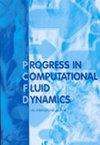纳米流体在锥形螺旋换热器中的传热数值模拟
IF 0.5
4区 工程技术
Q4 MECHANICS
引用次数: 7
摘要
本文采用氧化铝/水(Al2O3/水)和氧化铜/水(CuO/水)两种不同的纳米流体,对矩形截面锥形螺旋换热器的性能进行了数值研究。为此,研究了纳米流体浓度对二次流、压降、传热和性能系数(总传热与泵送所需流体的比值)的影响。在结构网格上,采用有限体积法求解了连续方程、动量方程和能量方程。结果表明,通过提高纳米流体的浓度,形成的二次流获得更大的动力。结果表明,随着纳米流体浓度的增加,沿管压降增大。在极低浓度的基础水中加入纳米颗粒,传热速率略有提高,但随着纳米流体浓度的增加,传热速率降低。此外,FOM随纳米流体浓度的增加而降低。与较低浓度的氧化铝纳米流体相比,氧化铜的这种差异更大,而较高浓度的氧化铝纳米流体的这种差异更大。本文章由计算机程序翻译,如有差异,请以英文原文为准。
Numerical simulation on heat transfer of nanofluid in conical spiral heat exchanger
In this research article, the performance of a conical spiral heat exchanger with rectangular cross sections is numerically investigated by using two different nanofluids, aluminium oxide/water (Al2O3/water) and copper oxide/water (CuO/water) nanofluid. For this purpose, the effects of nanofluid concentration on the secondary flow, pressure drop, heat transfer and figure of merit (FOM) (the ratio of total heat transfer to the required fluid for pumping) are investigated. On the structured grid, the continuity, momentum, and energy equations are solved by employing a finite volume method. Results indicate that by enhancing the concentration of a nanofluid, the formed secondary flow gains more power. Based on the obtained results, the pressure drop increases with enhancing the nanofluid concentration along the tube. The heat transfer rate is slightly increased by adding nanoparticles to the base water fluid in very low concentrations, but with increasing the concentration of nanofluids, the heat transfer rate reduces. Moreover, FOM decreases with increasing nanofluid concentration. This variation is higher for copper oxide compared to alumina nanofluids at lower concentrations, while it is higher for alumina nanofluid at higher concentrations.
求助全文
通过发布文献求助,成功后即可免费获取论文全文。
去求助
来源期刊
CiteScore
1.50
自引率
14.30%
发文量
33
审稿时长
7.5 months
期刊介绍:
CFD is now considered an indispensable analysis/design tool in an ever-increasing range of industrial applications. Practical flow problems are often so complex that a high level of ingenuity is required. Thus, besides the development work in CFD, innovative CFD applications are also encouraged. PCFD''s ultimate goal is to provide a common platform for model/software developers and users by balanced international/interdisciplinary contributions, disseminating information relating to development/refinement of mathematical and numerical models, software tools and their innovative applications in CFD.
Topics covered include:
-Turbulence-
Two-phase flows-
Heat transfer-
Chemical reactions and combustion-
Acoustics-
Unsteady flows-
Free-surfaces-
Fluid-solid interaction-
Navier-Stokes solution techniques for incompressible and compressible flows-
Discretisation methods and schemes-
Convergence acceleration procedures-
Grid generation and adaptation techniques-
Mesh-free methods-
Distributed computing-
Other relevant topics

 求助内容:
求助内容: 应助结果提醒方式:
应助结果提醒方式:


